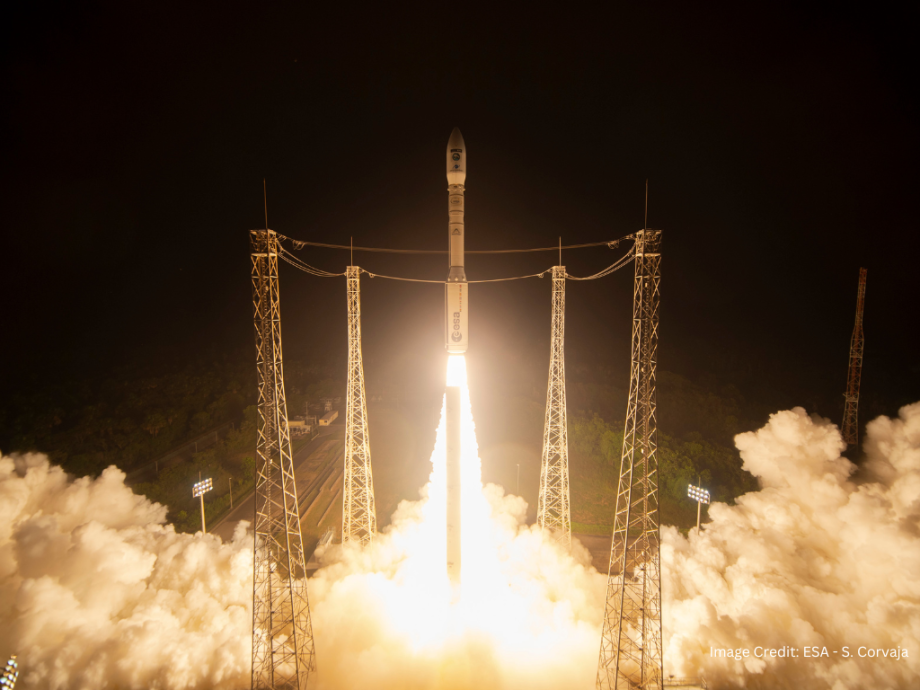The Copernicus Sentinel-2C satellite successfully launched on 5 September at 03:50 CEST (4 September 22:50 local time) aboard the last Vega rocket, flight VV24, from Europe’s Spaceport in French Guiana.
Sentinel-2C continues the legacy of delivering high-resolution data that forms an integral element of Copernicus – the Earth observation component of the European Union’s Space Programme. Developed, built and operated by the European Space Agency, the Copernicus Sentinel-2 mission provides high-resolution optical imagery for a wide range of applications including land, water and atmospheric monitoring.
The mission is based on a constellation of two identical satellites flying in the same orbit but 180° apart: Sentinel-2A and Sentinel-2B. Together, they cover all of Earth’s land and coastal waters every five days. Once Sentinel-2C is fully operational, it will replace its predecessor, Sentinel-2A, following a brief period of tandem observations. Sentinel-2D will eventually take over from Sentinel-2B.
Sentinel-2C was the last launch for the Vega rocket. After 12 years of service the original Vega is being retired to make way for an upgraded Vega-C.
Why Sentinel- 2C Matters
The launch of Sentinel-2C ensures the continued operation of the Sentinel-2 mission, securing the flow of critical data that scientists, governments, and industries rely on for decision-making. The data collected is used for a wide range of applications, including precision farming, water quality monitoring, natural disaster management and methane emission detection.
Sentinel-2 data is freely available via the Copernicus Data Space Ecosystem, providing instant access to a wide range of data from both the Copernicus Sentinel missions and the Copernicus Contributing Missions.
Supporting Australia’s Access to Copernicus Data
An agreement between the Australian Government (through Geoscience Australia) and the European Commission finalised in May 2016, brings all the Sentinel images of the region to the Copernicus Australasia Regional Data Hub. This hub replicates a subset of Europe's repository that meets the needs for reliable capture of, and access to, data from the Sentinel 1, Sentinel 2 and Sentinel 3 missions in the region. It is located and operated from the National Computational Infrastructure (NCI) in Canberra, Australia.
The Hub checks for new data every hour for products from the Sentinel 1, 2 and 3 missions and attempts to download these within one hour of them being available from the European hubs, ie, ESA and the European Organisation for the Exploitation of Meteorological Satellites (EUMETSAT).
Andrew Howard, Associate Director, Cloud Services and Innovation at NCI, says “I am delighted with the successful launch of Sentinel-2C, a major achievement which represents a crucial step forward in enhancing Earth observation capabilities and supporting vital applications that benefit the planet. He adds, “Sentinel-2C has the ability to capture highly detailed images of the Earth's surface. The data we receive is further processed by NCI partners and end users, transforming it into usable images suitable for various analytical applications. We are excited to support the wide range of research that this data enables.”
Geoscience Australia’s Sentinel Data Hub Engineer, Mike Peters, emphasises the satellite’s importance, stating, “Sentinel-2C’s launch is a major step forward in ensuring that Australia can continue to benefit from frequent, high-quality Earth observation data.
“This satellite will help us better manage our resources, providing data for monitoring land use and changes, soil sealing, land management, agriculture, forestry, and natural disasters such as floods, forest fires, landslides, and erosion. Additionally, it will support humanitarian aid efforts.”
Facilitating research across a broad spectrum of users is a core focus of NCI's mission. The Copernicus Regional Data Hub is paving the way for a new era of data-driven science. With NCI’s robust data management infrastructure, the program continues to deliver the high-quality service that researchers have come to expect, setting the stage for years of scientific breakthroughs.
